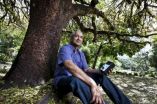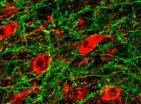Unexpected discovery reveals a new mechanism for how the cerebellum extracts signal from noise
Researchers identify the novel expression of an ion channel in neurons of the brain
2012-03-22
(Press-News.org) Research at the University of Calgary's Hotchkiss Brain Institute (HBI) has demonstrated the novel expression of an ion channel in Purkinje cells – specialized neurons in the cerebellum, the area of the brain responsible for movement. Ray W. Turner, PhD, Professor in the Department of Cell Biology & Anatomy and PhD student Jordan Engbers and colleagues published this finding in the January edition of the journal Proceedings of the National Academy of Sciences (PNAS).
This research identifies for the first time that an ion channel called KCa3.1 that was not previously believed to be expressed in the brain is actually present in Purkinje cells. In addition, these researchers demonstrate the mechanism by which this ion channel allows Purkinje cells to filter sensory input in order to coordinate the body's movements.
The discovery was unexpected, as Engbers explains, "we didn't specifically go looking for this channel. A lot of time was spent trying to identify the source for an electrical current that we were observing and we finally found ourselves asking 'what evidence is there that KCa3.1 isn't in the brain?' So we ran some tests and all the pieces really fell into place."
In the cerebellum, sensory input activates neurons called Purkinje cells that have to filter the information and respond only to relevant inputs to produce an appropriate movement response. Although this function of Purkinje cells has been well documented, Engbers and Turner take our understanding a step further by demonstrating that the KCa3.1 ion channel plays a key part in this process - acting as a gatekeeper to filter the enormous amount of incoming information.
As Turner explains, "these cells receive hundreds of thousands of signals every second from the body's sensory systems. KCa3.1 then allows the cells to filter out the background noise and respond to only the three or four inputs that are particularly relevant".
Engbers further describes the mechanism by which KCa3.1 filters out the unwanted information, "these channels are activated by an influx of calcium, which generates an inhibitory influence until the correct input is detected. Once the appropriate input is detected, the Purkinje cell responds with a burst of nerve impulses, which in turn initiates the proper motor response."
This research fills a substantial gap in understanding how neurons in the cerebellum process information. Engbers and Turner expect that continued research will identify KCa3.1 in other areas of the brain and that it will be responsible for several still unexplained phenomena observed in neuronal recordings.
"What we have found will help us understand how the cerebellum functions normally. Now that we have shown the scientific community this new information, we expect that it will become clear that KCa3.1 plays a much wider role in brain function," says Engbers.
INFORMATION:
This research was supported by grants from the Canadian Institutes of Health Research (CIHR), studentships through both Alberta Innovates – Health Solutions (AI-HS) and the T. Chen Fong Awards at the HBI and a Natural Sciences and Engineering Research Council (NSERC) Award. Lead authors Jordan Engbers and Dustin Anderson, PhD contributed equally to this work.
END
ELSE PRESS RELEASES FROM THIS DATE:
2012-03-22
Researchers from the Hotchkiss Brain Institute (HBI) and the Snyder Institute for Chronic Diseases at the University of Calgary's Faculty of Medicine have discovered a pathway that may contribute to the symptoms related to Crohn's disease and ulcerative colitis, collectively known as Inflammatory Bowel Disease (IBD). This research is a major milestone in developing future drug therapies for those living with these debilitating disorders.
The digestive process is complex. To coordinate the many functions involved in digestion, the gut has its own set of nerve cells ...
2012-03-22
USC Marshall study finds video capture and other automated systems cut down medical errors and minimize the tendency to operate outside normal procedures.
The Conrad Murray case can obfuscate that the vast majority of grave medical errors happen in hospitals—the places we think are most safe—and are often the result of bad systems. Poor transmission of information and unmonitored interventions yield problems in operations, recovery rooms and regular wards. But how can we minimize interpretive and procedural errors that are the root cause of most medical mistakes?
Research ...
2012-03-22
At some campuses, a fake driver's license is almost a standard accessory for college students. In a small sample of students at a branch of the State University of New York, more than three-fourths of students interviewed admitted that they carry false identification -- mainly to gain entry to bars and to buy alcohol.
When surveyed, many students admitted that it was challenging to convince bouncers that they are of legal age. Identification is carefully scrutinized, because bar owners do not want to jeopardize their state alcohol license by violating laws against underage ...
2012-03-22
Plants have long been known as the lungs of the earth, but a new finding has found they may also play a role in electrifying the atmosphere.
Scientists have long-suspected an association between trees and electricity but researchers from Queensland University of Technology (QUT), in Brisbane, Australia, think they may have finally discovered the link.
Dr Rohan Jayaratne and Dr Xuan Ling from QUT's International Laboratory for Air Quality and Health (ILAQH), led by Professor Lidia Morawska, ran experiments in six locations around Brisbane, including the Brisbane Forest ...
2012-03-22
Few people think about presidential pardons in racial terms. Even fewer people think about presidential pardons at all. But in a recent two-part article co-published by ProPublica and The Washington Post, an analysis of presidential pardon data seems to suggest that race may be a more important factor in presidential pardons than one might think.
Most presidential pardons go unnoticed; those that do not often leave the impression that the process is rife with political maneuvering and backroom favors. Criminals pardoned with presidential pardons are essentially returned ...
2012-03-22
ST. PAUL, Minn. – A new study suggests that older people may have an increased risk of problems with memory and thinking abilities after being in the hospital, according to research published in the March 21, 2012, online issue of Neurology®, the medical journal of the American Academy of Neurology.
"Our study is timely as the United States population continues to rapidly age and researchers try to identify factors that could reduce memory and thinking problems in the elderly," said study author Robert S. Wilson, PhD, of Rush University Medical Center in Chicago. "Understanding ...
2012-03-22
WASHINGTON — A new finding in basic science should trigger a "change in thinking" about how cancer drugs might be developed and tested for maximum effectiveness, says Louis M. Weiner, M.D., director of the Georgetown Lombardi Comprehensive Cancer Center, in a "Clinical Implications of Basic Research" article titled
Tumor-Cell Death, Autophagy, and Immunity published in the March 22 issue of the New England Journal of Medicine (NEJM).
An internationally known expert in immunotherapy research, Weiner was invited, along with Michael T. Lotze, M.D. from the University of ...
2012-03-22
A Carbondale woman, who charged a Carbondale police officer with unlawfully using his police cruiser to ram the all terrain vehicle (ATV) in which she was riding, has settled her Federal Civil Rights lawsuit against the officer and the City of Carbondale for $105,000.
In May 2009, Chelsea Rocuba, 17 years-old at the time, was a passenger in a legally registered and operated ATV when it was rammed by Carbondale Police Officer Timothy Mackrell using a "pit maneuver," a move commonly used by police forces. The pit maneuver involves the law enforcement vehicle ...
2012-03-22
Two breakthrough studies may explain why we see distinct patterns of brain damage associated with dementias, such as Alzheimer's disease, and could be useful for predicting future cognitive decline in patients. These independent studies published by Cell Press in the March 22 issue of the journal Neuron, one studying how brain circuits wire up structurally and the other studying their functional connections, converged on a remarkably similar model that predicted the landscape of degeneration in various forms of dementia. This is particularly significant because, until now, ...
2012-03-22
CHAPEL HILL, N.C. – What characterizes many people with depression, schizophrenia and some other mental illnesses is anhedonia: an inability to gain pleasure from normally pleasurable experiences.
Exactly why this happens is unclear. But new research led by neuroscientists at the University of North Carolina at Chapel Hill School of Medicine may have literally shined a light on the answer, one that could lead to the discovery of new mental health therapies. A report of the study appears March 22 in the journal Neuron.
The study used a combination of genetic engineering ...
LAST 30 PRESS RELEASES:
[Press-News.org] Unexpected discovery reveals a new mechanism for how the cerebellum extracts signal from noise
Researchers identify the novel expression of an ion channel in neurons of the brain

